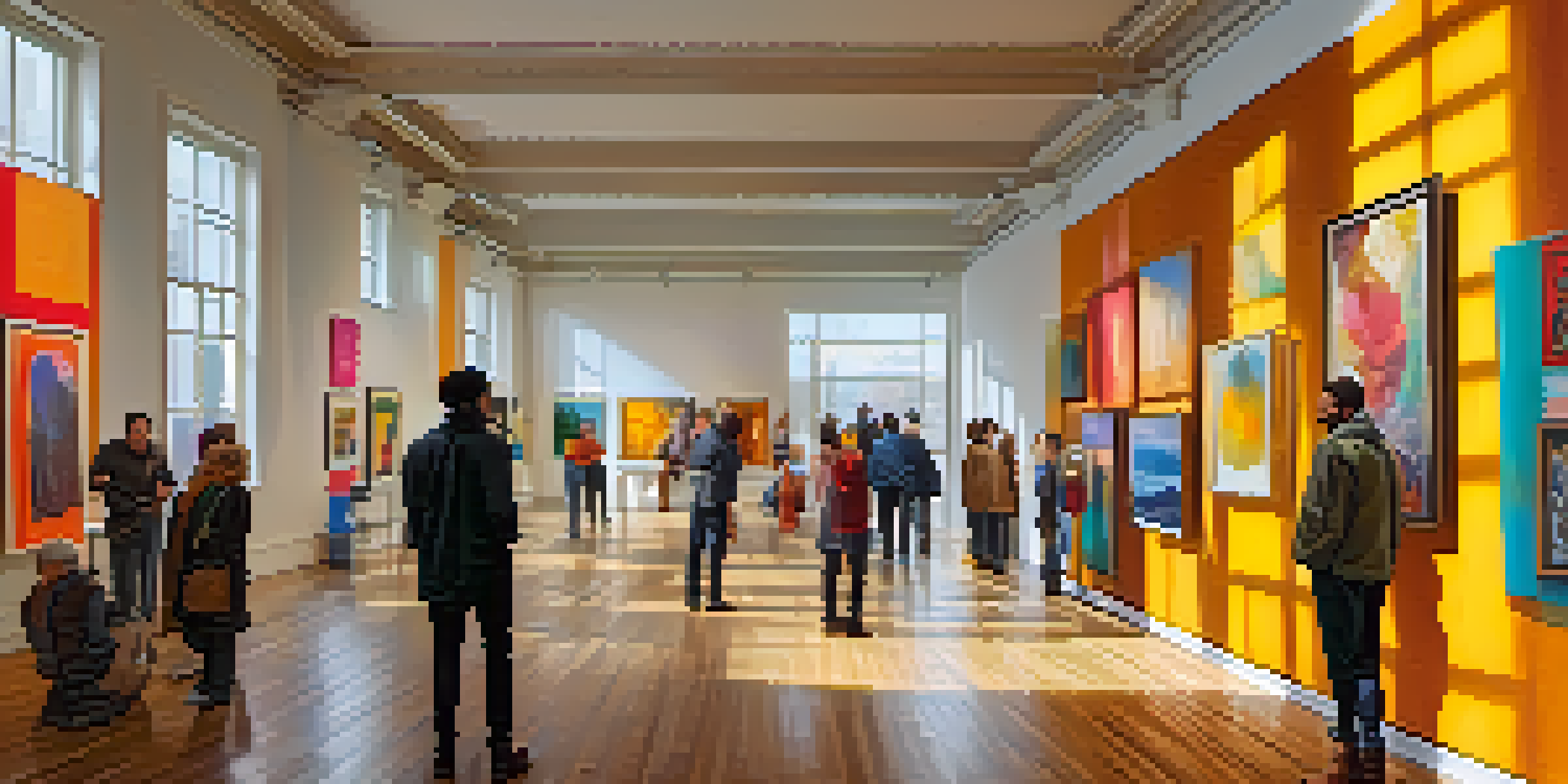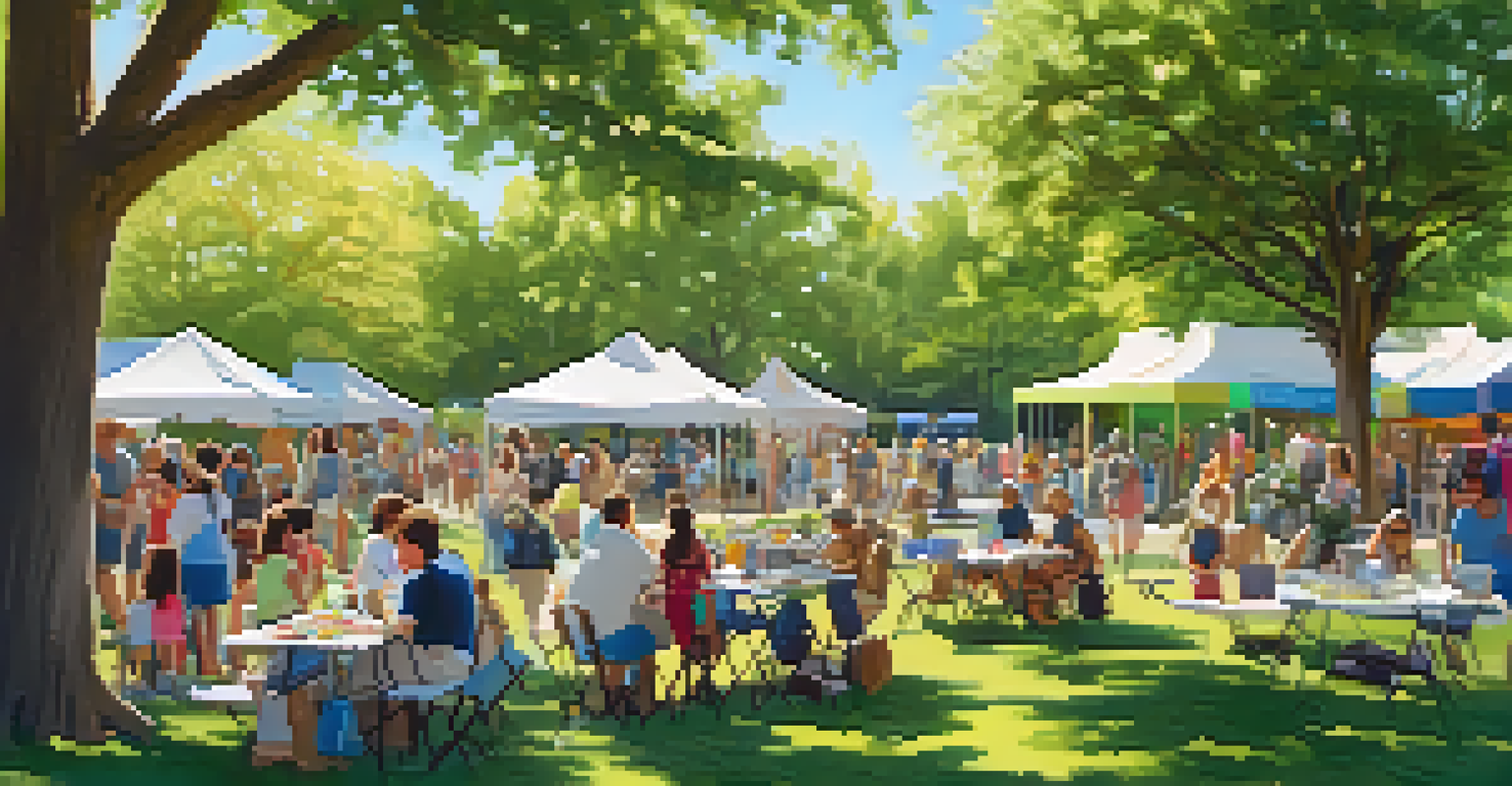The Impact of Art Galleries on Community Cohesion and Pride

Art Galleries as Community Hubs for Connection
Art galleries often serve as central gathering places in a community, bringing people together from various backgrounds. These spaces foster connections that might not happen elsewhere, creating a melting pot of ideas and experiences. When individuals come together to appreciate art, they share stories and perspectives that strengthen their bonds.
Art enables us to find ourselves and lose ourselves at the same time.
Moreover, galleries often host events that encourage participation, such as workshops, artist talks, and exhibitions. These activities not only engage local talent but also invite community members to contribute, making everyone feel part of the art narrative. This inclusivity is key to building a sense of belonging and connection among residents.
In many ways, art galleries act as social glue, weaving together the fabric of a community. By providing a platform for engagement, they help cultivate friendships and alliances, ultimately leading to a more cohesive society.
Promoting Local Artists and Cultural Identity
Art galleries play a crucial role in showcasing local artists, giving them a platform to share their work and stories. This not only elevates the artists but also highlights the unique cultural identity of the community. When residents see their own stories reflected in the art, it fosters a sense of pride and ownership.

By promoting local talent, galleries help sustain a vibrant cultural scene that attracts visitors and boosts the local economy. This ripple effect can lead to more opportunities for artists and contribute to the community's cultural richness. As local art flourishes, the community's distinct identity becomes more pronounced, creating a shared sense of pride among its members.
Galleries Foster Community Connections
Art galleries serve as social hubs that bring people together, fostering connections and a sense of belonging.
Furthermore, when communities support local artists, they are investing in their own cultural narrative. This creates a cycle of appreciation and recognition that strengthens community ties and encourages continued artistic expression.
Art as a Medium for Dialogue and Understanding
Art has an incredible ability to spark conversations around important issues, serving as a bridge for dialogue in the community. Galleries often host exhibitions that tackle social themes, allowing residents to confront challenges in a thoughtful and engaging way. This opens up pathways for understanding and empathy among diverse groups.
Every artist was first an amateur.
When people engage with art that reflects their own experiences or those of others, it can lead to powerful discussions. These conversations can challenge perceptions, break down barriers, and foster a more inclusive environment. Art becomes a catalyst for change, encouraging residents to reflect on their community and the world around them.
In essence, galleries not only display art but also provide a safe space for critical discussions. This dialogue fosters a deeper understanding of each other, ultimately strengthening the fabric of the community.
Enhancing Community Pride Through Artistic Expression
Art galleries contribute significantly to a community's sense of pride through the celebration of local talent and culture. When residents see their own stories and experiences represented in art, it instills a feeling of validation and pride. This connection to local art can evoke a deeper appreciation for their surroundings.
Moreover, galleries often collaborate with local schools and organizations to promote art initiatives. These partnerships empower residents to explore their creativity and take pride in their contributions to the community. As more people engage with the arts, the overall pride in the community's heritage and achievements grows.
Local Art Boosts Cultural Identity
By showcasing local artists, galleries highlight the community's unique cultural identity and instill pride among residents.
Ultimately, a thriving art scene encourages residents to showcase their community with pride, leading to a positive cycle of artistic expression and community engagement. This pride not only enriches individual lives but also strengthens the community as a whole.
Economic Benefits of Art Galleries in Communities
Beyond their cultural impact, art galleries can play a significant role in boosting the local economy. They attract visitors, both local and tourists, who contribute to the economy through spending on arts-related activities, dining, and shopping. This influx of visitors can lead to increased revenue for local businesses.
Additionally, galleries can create jobs and provide opportunities for local artists, curators, and event organizers. By investing in the arts, communities can stimulate economic development that benefits everyone. This economic boost can lead to further investment in public spaces and community resources, creating a vibrant environment for all.
As communities recognize the economic potential of art galleries, they become more likely to support and invest in these cultural institutions. This mutually beneficial relationship fosters a cycle of growth that enhances both the economy and community pride.
Art Galleries as Spaces for Learning and Growth
Art galleries are not just about viewing art; they are also spaces for learning and personal growth. Many galleries offer educational programs, workshops, and lectures that engage community members of all ages. These initiatives nurture creativity and critical thinking, enriching the community's intellectual fabric.
By providing access to art education, galleries empower individuals to express themselves creatively. This not only enhances their appreciation for art but also fosters skills that can benefit them in various aspects of life. When communities invest in art education, they are investing in the development of well-rounded individuals.
Economic Growth Through Art
Art galleries contribute to local economies by attracting visitors and creating job opportunities, benefiting the entire community.
Moreover, these learning opportunities often inspire collaboration and innovation within the community. As individuals come together to learn, they share ideas and perspectives, leading to a more vibrant and dynamic community.
Building a Lasting Legacy Through Art
The impact of art galleries extends beyond the present; they help build a lasting legacy for future generations. By preserving and showcasing local art, these galleries maintain a connection to the community's history and culture. This legacy becomes an invaluable resource for educating future generations about their roots.
Art galleries often create archives and collections that document the evolution of local culture, serving as a testament to the community's journey. This historical context fosters pride and understanding, instilling a sense of responsibility to carry forward the community's story.

As communities recognize the importance of preserving their artistic heritage, they are more likely to support local galleries and initiatives. This creates a sustainable model for future artistic endeavors, ensuring that the impact of art continues to resonate for years to come.